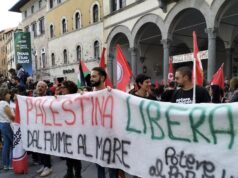Even if in the context of the 1952 revolution the centrality of mining workers was indisputable, today the shape of the working class has changed. It is true that manufacturing workers remain an important part of the Bolivian working class, but the casualisation of labour relations and informal economy have created a large majority of the working class facing unfavourable conditions for organising. By Bruno Miranda

In Bolivia there have been at least seven important uprisings in the last decade, based on the struggle over the control of natural resources [1]. Among these it is worth mentioning the battle normally called the “Gas War” of September-October 2003, and the “Second Water War” in May-June 2005, both of them in the city of El Alto.
In this city, migrants from the countryside – who bring with them communitarian traditions of land cultiviation and everyday political life – and redundant ex-miners – who bring the experience of more than 30 years of decisive control over matters of state (1952-1985) – are brought together in an urban context. The co-existence of these two populations, as well as migrants from La Paz, students and an Aymara intelligentsia which has grown since the late 1960s, was expressed in a new multitude form in 2003 and 2005.
In these struggles in which working-class and peasant trade unionism co-existed with Andean communitarian practice [2], neighbourhood organisation outside of Bolivia’s bourgeois political parties resulted in mobilisations which brought down two successive presidents.
Although trade union federations were involved, among them the Central Obrera Boliviana in the struggle against the export of gas to California via Chile and the struggle against high water rates, the protagonists were the hundreds of Residents’ Associations in El Alto, which spoke for all the organisations in struggle, including those from other parts of the country. Although they were based on district organisation, these were in the last instance associations of extra-proletarianised workers, such as street-sellers, contracted labour, ex-miners and migrants from the country.
A brief history of El Alto

In the journey from the countryside to the city – taken by thousands of Bolivian migrants every day – the destination is almost always the city of El Alto, on the Bolivian altiplano. At 4,000 metres above sea level and with a population of over 1 million people (according to unofficial figures) El Alto has received migrants since the 1980s, or more precisely, 1985, when the Paz Estenssoro government promoted the “re-homing”[3] of miners with decree 21060 [4], broke up the working class. This meant that the locum of struggle then moved on to the coca planters of the valleys of Cochambamba and then, in the 21st century, the workers of El Alto organised in Residents’ Associations.

El Alto’s history of struggle is not only a matter of recent times. In 1781, in resistance to Spanish taxes, the Aymara leader Tupak Kataria and his comrade Bartolina Sisa formed indigenous armies which encircled the city of La Paz from March to July and August to October of that year. The ultimate objective was the expulsion of the Spanish by blockading food supplies and starving them out. In the end, Tupak Katari was condemned to death and quartered in public by four horses. His figure became a symbol of struggle not only for Aymara and Quechua peasants but for the workers’ movement itself and the urban proletariat of indigenous descent, including a small proportion of mestizos and whites.
More than a century later, during the so-called Federal War, under the leadership of the Aymara Pablo Zárate Willka, the constitutionalist troops of then president Fernández Alonzo were prevented from passing through El Alto en route to La Paz. The intention was to protect the liberals so that they might legislate in favour of the indigenous territories, which in fact did not happen. The indigenous people then organised independently and decreed a new form of indigenous government, calling for the destruction, seizing and burning of private properties and the physical elimination of the mestizo and white elite.
Then, in 1952 during the national revolution, in El Alto there were controls on the coming and going of troops from the mines, as well from the air force which still today is based in the city. It was the backdrop to the victory of the revolution.
In recent times the city served as the reference point for working-class struggles in Bolivia, such as had existed elsewhere decades before during miners’ struggles. Known as the “Poor people’s HQ” El Alto has been compared to the Siglo XX miners’ encampment north of Potosí, from which emerged the ideas and political direction followed by the proletariat in the 1952 revolution[5].
The city of El Alto only officially became a municipality independent of La Paz on 26th September 1988. It is geopolitically important not only because it is the main entry and exit route for La Paz – which is literally in a hole in the middle of the Andes – but also because it leads to the northern altiplano – where can be found the most combative peasant communities in Bolivia such as Achacachi, Warisata, Sorata, Huanuni and Copacabanda – and the southern altiplano – where can be found Caracollo and the mining centre of Oruro. It also serves as the pathway to the Amazon region for the departments of La Paz, Beni and Pando.
According to the 2001 census El Alto has 649,958 inhabitants, 28% of the La Paz department. But, as Ramírez (2005b) reminds us, on the day of the census innumerable families would have gone to their areas of origin to register. According to other sources the population had already surpassed the 1 million mark in 2000.


Given the size of its population growth, it is considered the first large city of indigenous people on the continent. However, Duran Chuquimia has presented some statistics on the living standards of most of the population. According to his dossier 77% of homes are clay and only 22% of its walls contain bricks, the majority without grouting; 47.9% have concrete floors, 28.1% wood and 21.8% earth; 60% of houses do not have a registered owner; 46% still lack basic sanitation and guttering for rain water, even though at times there can be torrential downpours. In 2005, El Alto counted some 66.8% of its urban population as in a state of poverty. In the rural area of the municipality the figure was 98.9%. Among this group, 17.1% live in destitution.
An important figure reflected in the socio-political scenario is that 85% of homes are built by their inhabitants, as well as the paving of the streets and the district environment itself. This allows for a sense of belonging to the district, which each worker can express in moments of confrontation and protest. It is a city in permanent construction.
The world of the El Alto worker
Consequently there has grown an informal sector: eight out of ten jobs created in Bolivia in recent years are in this sector. In the city of El Alto the family sector – that is to say, micro- and small businesses staffed by members of the same family – grew 1120% between 1989 and 1995.
Workers from El Alto are predominantly concentrated in trading and manufacturing. Trading, followed by industry, is the sector in which informal work has expanded to dizzy heights. At the same time, El Alto is the country’s second manufacturing city in absolute terms, after Santa Cruz de la Sierra, according to the 2001 census.
Using a different methodology, Rojas and Rossell point out that, while in 1992 64% of El Alto residents worked in the informal sector (family and/or petty employers), by 2000 the number had gone up to 69%: the main unit of capital reproduction in El Alto is the family.

Although these workers can administrate their working time with more autonomy, the realisation of capital takes place by means of self-exploitation or extraction of surplus value from the family itself. Abusive labour contracts and ones which generate surplus value from the family are covered by relations of parenthood or marriage.
In the current context, after the lay-offs of the 1980s and the decentralisation of industry, workers in the home and small workshops remain subordinate to the productive dynamics of big industry, since in no few cases these small workshops produce to meet its demands. Forms of work which are not totally capitalist, like in associations or family and/or community production are not eliminated but subsumed and become part of the general valorisation of capital.
The effects of Decree 21060 and its politico-theoretical implications
Recently the intellectual and activist milieu in Bolivia has discussed at some length the current configuration of the urban proletariat. If, in the context of the 1952 revolution, the centrality of mining workers was indisputable, today, after the mass lay-offs starting in 1985, the morphology of the workforce has certainly changed. Similarly, if it is true that manufacturing workers still represent a significant portion of the Bolivian working class, it would be dishonest to deny that the casualisation of work relations and informality have created a large majority of the working class facing unfavourable conditions for organising.
Besides massive lay-offs, the restructuring of Bolivian mining meant re-homing some 4,000 miners from private companies, another 60,000 from what remained of the state miner COMIBOL and more than 500 co-operatives and smaller mines spread across the country.
We agree with Antunes when he refuses to accept the substitution of work by science or value production by communications: in the contemporary world there is ever more interchange between productive and unproductive work, industrial work and informal or service-sector work.

What is new, however, is the combination of productive processes on a large scale with other minor and more flexible processes. Thus self-employed workers, traders, street-sellers and artisans, without being directly subsumed into a large capitalist enterprise, contribute to value realisation in the sense that they participate in the buying and selling of contraband goods and sell them below price to the working class, reducing the use value of labour power itself. This is an international phenomenon expressed by the growing numbers of an unorganised and atomised type of wage-worker.
However, the numerical reduction of the industrial working class does not mean we have to join the ranks of those who defend the idea of post-industrial societies, since the informal and service sectors are in general dependent on large-scale industrial production and its possibility – or not – of creating value.
The new shape of the world of work in El Alto is also present in other urban centres of Latin America: São Paulo, Rio de Janeiro, Buenos Aires and Santiago in the southern cone; and Lima, Quito, Bogotá or Caracas in the Andes; also suffering the same effects of neoliberalism. Understanding the dynamic of surplus-value appropriation in contemporary regional capitalism necessitates deepening the debate on informal economy. In terms of the Bolivian altiplano, the radicalism of its workers mixed with the oppressed condition of indigenous people – whether Aymara or Quechua – draws our attention to its historic potentialities.
Future perspectives
Beyond the factory floor and the workplace, in Bolivia it is clear that excess appropriation is taking place via overarching measures such as the privatisation of natural resources, in the last instance an obstacle to the redistribution of tax. Given that these mobilisations are in response to excessive underlying expropriation, led by multinational consortiums, they show new elements common to community struggles and working-class trade unionism, worthy of political articulation.

On the other hand, although clashing with the state and multinational capitalism and also giving political and social support to the first Evo Morales/MAS government, these movements of the multitude did not manage to force the completion of the “October agenda”[6]. From the MAS’s ascension to the Palacio Quemado in 2006 until today, the main organisations which mobilised people in previous years have been defending government decisions.
The governing party strategically negotiated with the Central Obrera Boliviana, Central Obrera Regional de El Alto, Federación de Juntas Vecinales-El Alto, and Federación de Gremiales, as well as being able to count on the support, from the start of its first campaign, of the Confederación Nacional de Mujeres Campesinas Indígenas Originarias de Bolivia Bartolina Sisa, the partial support of the poweful Confederación Sindical Unica de Trabajadores Campesinos de Bolivia and the coca growers’ unions of the Chapare region. At the same time it negotiated with landowners’ representatives like the Comité Cívico de Santa Cruz and fascistic youth organisations like the blood-stained Unión Juvenil Cruceñista. In other words, MAS has functioned like a land-leveller, promoting alliances in search of national unity.
The last elections on 6th December were also an expression of an earlier point: in the La Paz department, in which El Alto was MAS’s greatest bastion, Evo Morales won 78% of votes, as against 11% for his opponent Manfred Reyes Villa. Nationally he won 63% of votes, 25 of 36 members of the senate and 85 of 130 MPs. For the next five years we can forecast a certain stability for the MAS government.
It has been made clear that the community mobilisation and the autonomy of the mobilisations of 2003 and 2005 instrumentalised the critique of the left, in its practical form, parliamentary democracy and democratic capitalism. It ripped off the mask of capital accumulation and electoral democracy as part of a power structure co-opted by capital.
However in doing so these mobilisations are, contradictorily, prevented from spreading into wider urban spaces and for longer periods of time. The bourgeoisie permit assemblies, face-to-face relations, the alternative use of time and control of authority only in small degree and as long as they are not confronted. In more ordinary times, the state will return to exercise its politico-juridical-military dominion over social relations.
Notes
[1] The insurrections began in 2000 with the “Gas War” in Cochabamba, followed by the communal-peasant blockades of April and September that year, and another in June 2001.
[2] Andean society revolves around the ayllu, the organisational set-up of poor Andeans. The essence of communal autonomy exists on a complex and varied system of elected authorities and direct democracy, accompanied by a system of communal justice.
[3] Euphemism used to designate mass lay-offs of miners
[4] Around 32,000 miners were sacked on the pretext of rehoming under the Paz Estenssoro government’s 1985 Decree 21060
[5] Huanuni, in the north of Oruro department, is another historic site of struggle for mining workers. It was the centre of the establishment of the FSTMB miners’ union in 1944 and the working-class base in the 1952 revolution and for decades after.
[6] A series of demands including the nationalisation of gas plants, the resignation of then president Gonzalo Sánchez de Lozada, rejection of the ALCA free trade deal, freedom for the Universidade Pública de El Alto and better conditions for agricultural workers.
Translated by The Commune. Original at http://passapalavra.info/2010/02/18339.





